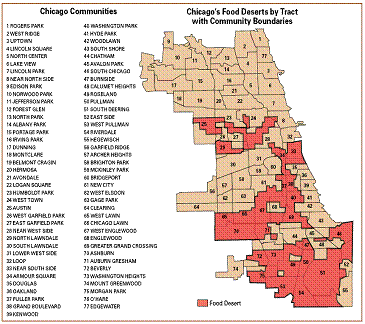Problem: Urban Food Deserts and Their Impact on Children
(contributed by Christie Manisto and Adam Stubbendick)
A food desert is a community with little or no access to grocery stores and quality, nutritious food choices. In urban areas these deserts are compounded by easy access to non-nutritious food located in convenience stores, liquor stores, and fast food restaurants. In areas that have been defined as food deserts, people suffer from obesity, diabetes, cardiovascular disease, and hypertension at a greater rate than those living in other urban areas.
Chicago Food Deserts

In our own urban area of Chicago, over half a million residents live in the city’s three large urban food deserts, mostly on the south and west sides of the city. The vast majority of those living in Chicago’s food deserts are African American. Those living in these areas have to travel on average twice as far to a grocery store as they do to find a fast food restaurant.
The Food Desert Crisis and Its Impact on Inner City Children
The Food Desert crisis in our urban areas affects all members of the community, however children are victims of this injustice in a profound way. Long-range studies have shown that lack of access to proper nutrition can result in among other things, poor school performance, behavioral issues, and severe long-term health effects. One major health problem that is affecting children disproportionately in poor areas with lack of access to is that of childhood obesity. While it may seem strange, that lack of access to food may cause one to become obese, this is indeed found to be the case, most often because, according to a Cornell University study:
“Low income people may consume greater amounts of less expensive, high-calorie and high-fat foods to guard against hunger, or may be unable to afford sufficient amounts of more nutritious food. Cash-strapped families may increasingly rely on fast food chains, which promote "value" meals, such as oversized burgers, extra-large servings of fries and buckets of soda. Healthier foods – such as meat, fish, fresh fruits, vegetables and whole grains – often are more expensive than alternative junk food.”
Studies have been conducted in several urban areas in the United States around the issue of poverty and childhood obesity. These studies have overwhelmingly concluded that children in poor neighborhoods, from low-income backgrounds are at a greater risk of becoming obese and unhealthy as a result of lack of access to nutritious food. One example of this is a recent study done on children and access to food in inner city East Los Angeles. The study took a look at the type of food that was accessible within and around this community and found that in East Los Angeles:
“…of the 190 food outlets, 93 (49%) were fast food and of the 62 grocery stores only 18% sold fruits and vegetables found that resulting from the limited access to healthy food options, these children had a higher rate of obesity than children in their same age range in higher socioeconomic levels...”
FOOTNOTES
This definition and much of the information in this section is from a study by the Mari Gallagher Research and Consulting Group entitled “Examining the Impace of Food Deserts on Public Health in Chicago” from 2006. The entire report and a summary of its findings are linked to on the resources page.
Childhood obesity is defined by a Mayo Clinic study as: “a serious medical condition that affects children and adolescents. It occurs when a child is well above the normal weight for his or her age and height. Childhood obesity is particularly troubling because the extra pounds often start kids on the path to health problems that were once confined to adults, such as diabetes, high blood pressure and high cholesterol.”
Bread for the World “Obesity and Hunger” http://www.bread.org/learn/us-hunger-issues/obesity-and-hunger.html
Michele D. Kipke , Ph.D. a , Ellen Iverson , M.P.H. a , Deborah Moore , M.A., Cara Booker , M.P.H. a , Valerie Ruelas , L.C.S.W. c , Anne L. Peters , M.D. d , Francine Kaufman , M.D. c “ Food and Park Environments: Neighborhood-level Risks for Childhood Obesity in East Los Angeles” Journal of Adolescent Health Vol. 40, Issue 4 (April 2007) 325-333.